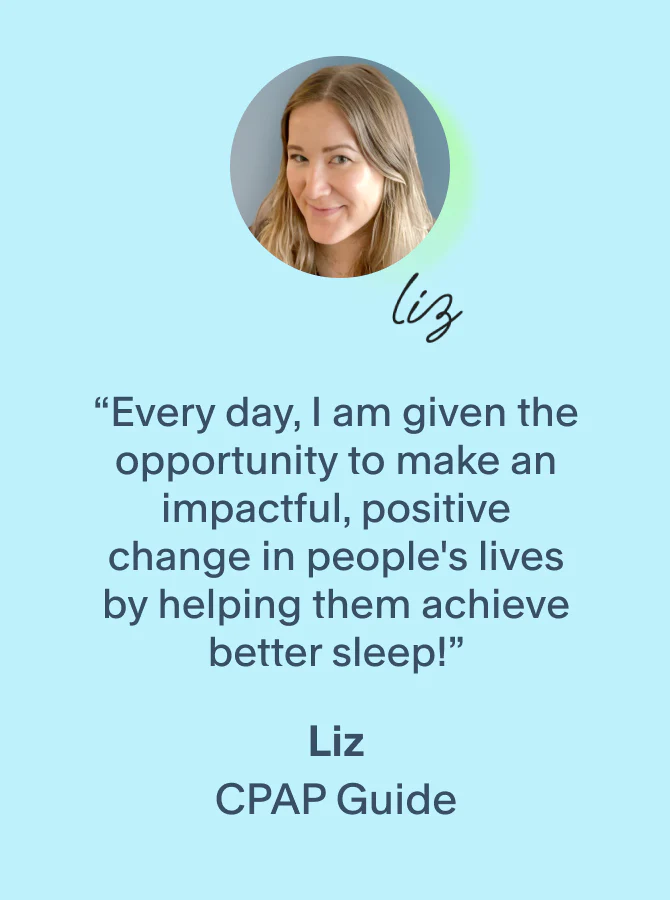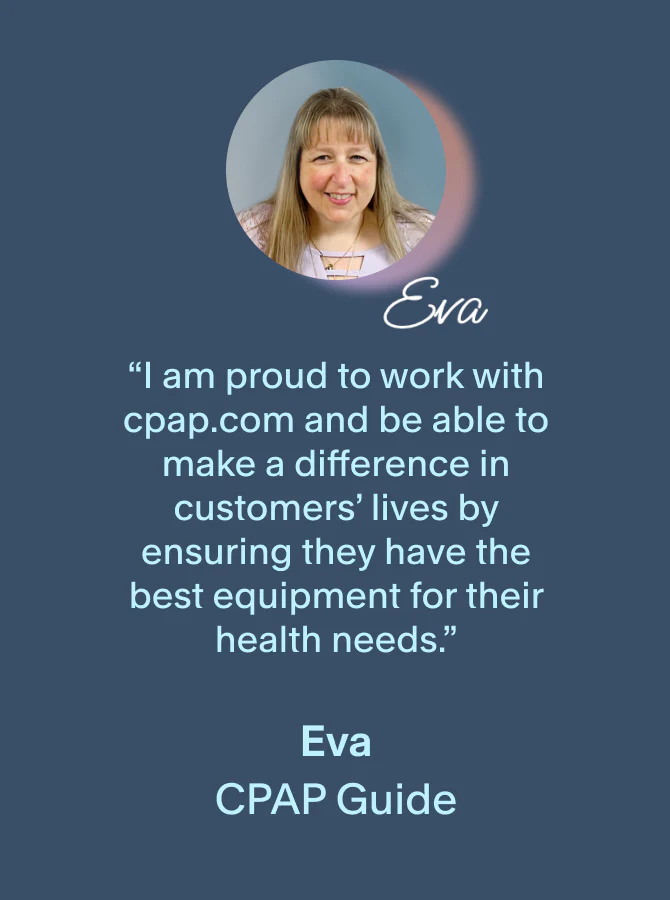With more people living with sleep apnea than ever before, and 80% left undiagnosed, making sure people understand their options for sleep apnea testing is so important.
If you've noticed loud snoring, headaches, or feeling tired throughout the day, those are all signs that you need to be evaluated for sleep apnea. To confirm your diagnosis, you'll need to undergo a sleep test, but which one?
You'll have the option of choosing between a home sleep test versus a lab sleep test, but the right one for you will depend on the severity of your symptoms and the type of sleep apnea you are at risk for.
Today, we'll explain how HSTs and lab sleep tests work, what they do, who can use them, and how they stack up against each other. We will also talk about choosing the right sleep apnea test for your situation, so you get the answers you need with results you can trust.
At a Glance: Home sleep test versus lab sleep tests
Comfort & Convenience: Home sleep tests are done in your own bed with minimal equipment for a more natural sleep experience, while lab tests are performed in a sleep clinic with multiple sensors.
Cost: Home sleep tests typically cost under $200 and are often paid out-of-pocket, while lab sleep studies can range from $4,000 to $15,000 and may require insurance approval and billing.
Results:
Home sleep test results are usually available within a few days, while lab test results may take weeks due to longer scheduling times and more complex data review.
Diagnosis: Home sleep tests are designed to diagnose mild to severe OSA, while lab studies can detect all types of sleep disorders, including obstructive, central and complex sleep apnea.
Subjects: Home sleep tests are ideal for healthy adults with clear OSA symptoms or those needing routine screening for work. Lab studies are better suited for individuals with underlying health issues or risk for non-obstructive sleep apnea.
Equipment & Setup: Home tests use compact, easy-to-use devices—sometimes as small as a finger sensor—whereas lab tests involve full-body monitoring with electrodes, nasal cannulas, belts, and more.
Treatment Planning: Home sleep tests often lead to automatic CPAP or APAP prescriptions, while lab studies may include a titration phase to fine-tune therapy pressure settings on the same night or in a follow-up session.
Comparing home sleep tests versus lab sleep tests
There are a couple of ways to diagnose sleep apnea.
While lab studies are more in-depth and able to detect all types of sleep apnea, most people who are suspected to have obstructive sleep apnea (OSA) can get an accurate and reliable diagnosis through a home sleep test, especially if they don’t have other health conditions.
Known as a polysomnogram or PSG, these comprehensive sleep tests are performed by a licensed sleep technician at a sleep testing clinic and can be used to diagnose any type of sleep disorder, including all types of sleep apnea. These tests cannot be performed without a pre-approved order from your doctor.
An HST is a simplified sleep study completed in the comfort of your own bed, using a small monitoring device to diagnose obstructive sleep apnea. These tests are quite popular thanks to their user-friendliness and quick results. While they also require a doctor's order, they are easier to request and can even be purchased online and approved following a quick telehealth visit.
Polysomnography (in-lab) diagnostic capabilities
Traditional polysomnography records brain waves, breathing effort, heart rate, oxygen levels, and muscle movements during the various stages of sleep.
An in-lab sleep study is a more invasive experience, but the data it records is also much more comprehensive. The results of a PSG test can be used to diagnose nearly any sleep disorder (not just the three types of sleep apnea) and determine the severity.
Sleep disorders that can be diagnosed by an in-lab sleep test:
- Obstructive sleep apnea
- Complex/mixed sleep apnea
- Central sleep apnea
- REM sleep disorders
- Sleep-related seizures
- Restless leg syndrome
- Narcoleps
- Insomnia
Home sleep study diagnostic capabilities
Home sleep tests have a high level of accuracy when diagnosing obstructive sleep apnea. While this may sound limiting, it is by far the most common form of sleep apnea, with 90% of cases involving OSA.
So, if you are showing signs of sleep apnea and you don't have a complex medical history, you are most likely a good candidate for sleep apnea testing at home. These tests may also be used by people who are required to complete sleep apnea screenings for their job, for example, truck drivers, aircraft pilots, military members, etc.
As for other conditions, the American Academy of Sleep Medicine (AASM) does not recommend using an HST as a general sleep health screening for people who are not experiencing symptoms of OSA and are not considered at risk.
Sleep disorders that can be diagnosed by a home sleep test:
- Mild obstructive sleep apnea
- Moderate obstructive sleep apnea
- Severe obstructive sleep apnea
How to choose between home sleep study and in-lab
An in-lab sleep study should only be used when necessary and for people who absolutely need it. Certain authorities, such as the Department of Transportation, require specific workers (such as commercial truck drivers) to be annually screened for sleep apnea.
If you or your health care provider suspect that you are at risk for Obstructive Sleep Apnea and you do not have any previous or underlying health conditions, then congratulations! You’re most likely eligible for a home sleep study.
If, however, you have a history of significant heart or lung disease, a neuromuscular condition such as ALS or MS, stroke, chronic opioid use, or significant pre-existing sleep disorders, you’ll have to do a sleep study in a lab for the most comprehensive diagnosis.
Sleep Well, Live Well
Our home sleep test brings expert diagnosis right to your doorstep, so you can start your journey back to the vibrant world of great sleep.
✗ No labs
✗ No wires
✓ Just sleep

Key differences in sleep testing equipment
What makes or breaks the sleep testing experience for a lot of people is the equipment used for the test. It’s what makes a lab sleep study so much more comprehensive than a home sleep study—though not all home sleep studies use the same equipment.
While undergoing a sleep study in a lab, you can expect to be hooked up to several electrodes attached to your chest, stomach, legs, scalp, and various points on your face. You may also be equipped with a nasal cannula to measure airflow, a chest belt to measure breath volume and frequency, and a pulse oximeter on one finger to measure oxygen saturation in the blood.
Home sleep testing equipment has come a very long way in the last decade, and there are a variety of options available for home testing. Typically, you’ll have a chest belt, pulse oximeter, nasal cannula, and chest electrode.
The more technology advances, however, the more minimalist a home test can be. The SleepAgain Home Sleep Test by Ectosense is a fantastic example. This particular HST only uses a small finger attachment, similar to a pulse oximeter, for one of the most minimalist home sleep test experiences available.
At home sleep study vs lab sleep study cost
For many, the cost of an overnight sleep study is going to be the determining factor when choosing between a home sleep test versus a lab sleep test.
HSTs are usually less expensive, often between $150-$350, while lab testing can run thousands of dollars, even with health insurance.
Average Cost of Lab Sleep Testing
| City | ZIP Code Tested | Out of Network | In-Network |
| San Antonio, Texas | 78250 | $14,933 | $7,367 |
| Knoxville, Tennessee | 37922 | $10,766 | $5,222 |
| Los Angeles, California | 90011 | $10,594 | $5,890 |
| New York City, New York | 11226 | $9,757 | $4,447 |
| Chicago, Illinois | 60629 | $8,272 | $4,580 |
| Phoenix, Arizona | 85032 | $8,259 | $3,662 |
| Lincoln, Nebraska | 68516 | $7,193 | $4,042 |
| Sheridan, Wyoming | 82801 | $7,037 | $3,775 |
| Portland, Oregon | 97206 | $5,969 | $3,230 |
| Gainesville, Florida | 32608 | $4,599 | $2,175 |
| Average Cost: | $8,738 | $4,439 |
Using FAIR Health Consumer, we looked at the average pricing for an in-lab sleep study for five of the most populated United States cities and five smaller and more secluded cities:
Despite insurance coverage, the cost of a lab sleep study in a modern setting averages around $4,500 in the United States with the potential to pay upwards of $15,000 in some extreme cases.
Most healthcare providers will not schedule a lab sleep study for you without first confirming your insurance coverage, however, and the actual out-of-pocket cost is typically much lower than the bill itself.
Those with Medicare or Medicaid coverage will have much lower bills on average, but pricing depends on other factors such as the provider’s billed rate, the facility, whether you’ve already met your deductible for the year, and any other insurance you may have.
You can use the FAIR Health tool to learn more about the average cost of participating in a lab sleep study in a sleep center near you.
Related Readings: Does Insurance Cover At-Home Sleep Apnea Tests? & Medicare Coverage For CPAP Equipment
HSTs are much more comfortable compared to polysomnograms
Another area that poses a significant difference in experience is the level of comfort you might enjoy during an at-home sleep study vs in-lab polysomnography.
On the home sleep test side of things, most tests are designed to be minimally invasive to provide a non-intrusive experience that allows for better sleep quality. You’ll be sleeping in your own bed—an environment that you’re familiar with, comfortable with, and most importantly, accustomed to falling asleep in.
In terms of lab sleep studies, the sheer amount of sensors and equipment will almost certainly affect your sleep quality. Then, factor in sleeping in an unfamiliar environment under observation by a sleep technologist and you have the perfect recipe for fragmented sleep.
For these reasons, sleep centers have come a long way in terms of comfort despite all of the extraneous medical equipment. A good sleep center will put effort into making the testing environment as comfortable as possible.
While it won’t compare to sleeping in your own bed with far fewer attachments (especially if you’re considering the minimalist SleepAgain device), you can expect that a sleep center will feel less like spending the night in a hospital bed and more like sleeping in a hotel room.
How long does a home sleep study take vs in-lab?
While you’ll typically spend one to three nights participating in either a lab or a home sleep study, there are some key differences to be aware of.
Your Apnea-Hypopnea Index is the average number of Apneas and Hypopneas you experience per hour and is considered the most relevant metric in determining the severity of your sleep apnea.
One night of recorded sleep does not necessarily paint a full picture of your sleep health or average Apnea-Hypopnea Index (AHI), as evidenced by this 2012 study of multi-night polysomnography. However, even with a single-night sleep study, your provider should easily be able to determine your level of risk for or the severity of your sleep apnea. Keep in mind, though that with all of the extra equipment in-lab, it will be difficult for you to attain the same level of sleep quality you can expect at home—not impossible, but difficult.
It’s also worth noting that you may be asked to return for a CPAP titration study in the event you’re indicated as a candidate for CPAP therapy, though some people also undergo titration on their first night. In a titration study, you’ll also be hooked up to a CPAP machine, and your sleep technologist will test a range of pressures while you sleep to determine which pressure is best for you.
Since most home sleep studies prescribe APAP machines, a titration study is not required, and due to the minimal nature of most home sleep studies, you typically only need one night for good results. Some companies prefer to use a three-night average for a more comprehensive result, but many accomplish their goals in a single night.
How long does it take to get results from a sleep apnea test?
Finally, we have the average time you can expect to wait before you receive your sleep apnea test results.
Home sleep testing is the winner here, but it’s not to say that the results of your lab study can’t be expedited if necessary; there’s simply more data to review and analyze compared with a home sleep study. That said, most home sleep tests promise a turnaround time of less than a week, with some promising a diagnosis in as little as two days!
Once you’ve received your diagnosis and decided which route to take in acquiring your PAP equipment (assuming you were diagnosed with OSA), you shouldn’t be more than a few weeks out from the start of your sleep apnea therapy.
As a bonus, opting into an at-home sleep study—assuming you meet the criteria—can even help those that truly need lab sleep studies by reducing demand on local clinics and shortening wait times.
Sleep labs typically have long waiting periods, which can be problematic for those seeking diagnosis for more serious health concerns. It’s not uncommon to have to wait six to eight weeks, or even longer, just to get into a sleep lab, but that should not at all deter you from seeking the proper level of medical attention.
If the sleep center you were recommended to has a long waitlist, you might ‘shop around’ and try a facility in a nearby city instead. Despite long waits, remember that a home sleep test is not a substitute for a lab sleep test for those that genuinely need it.
All said and done, home testing is king when it comes to quick results and overall time to getting relief from Obstructive Sleep Apnea if you don’t have other underlying health conditions.
Final thoughts
There are pros and cons to each type of sleep study, so hopefully you now have a better understanding of which one might better suit your needs. While not created equal, there are major benefits to being tested—period.
If you’ve been told repeatedly that you’re a loud snorer, are constantly fatigued during the day, or never seem to wake up feeling refreshed, it’s a great idea to talk to your healthcare provider or book a consultation with our telemedicine partner today to discuss your options for home sleep apnea testing!










